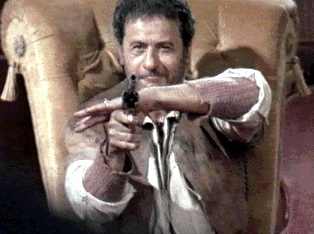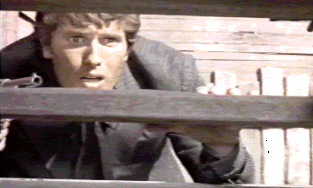|
|
THE
SPAGHETTI WESTERN GENRE
Part One

Eli Wallach as Cacopoulos in Ace High
British correspondent Lee Broughton offers a full historical rundown on the Italian
Western, a genre that has inspired the tone and content of every 'action' film trend
that followed it. Another Savant essay on Films You May Not Know About, but that will
hopefully be discovered by DVD. - GE 4/29/00
When Eli Wallach was offered the role of Tuco in Sergio Leone's third
Spaghetti Western, The Good, The Bad & The Ugly, his first thought
was, ' "Spaghetti Western?" That's like Hawaiian pizza.' Last week, when
I telephoned a reputable retail outlet to question the availability of a
certain Spaghetti Western on DVD, the puzzled silence that met my
enquiry seemed to scream, '"Spaghetti Western DVD?" That's like Scottish
pasta.'
Wallach's assumption, all those years ago, was understandable,
if incorrect. In 1966, he couldn't have known that cinema audiences in
most non-English speaking countries around the world had already
accepted the concept of Italian Westerns and were attending screenings
of these so called Spaghetti Westerns in boxoffice-shattering numbers.
But why, in the year 2000, should an employee of a major video and DVD
retail outfit suggest that coupling the words "Spaghetti Western" with
"DVD" could only result in a contradiction in terms?
It seems that over the years, genre enthusiasts, by ganging together and
chewing the
Spaghetti cud within increasingly marginalised groups, have failed to
realise that the genre has been all but forgotten by the rest of the
English-speaking world. Despite the influence of the genre still being
found in modern day action flicks and various areas of the media, it
seems that, for many people, the term 'Spaghetti Western' is simply a
throwaway phrase that is used to describe four or five films made by
Sergio Leone. But Leone's films, seemingly the only genre films to have
retained any kind of a public profile, actually inspired the production
of over six hundred other European Westerns. And in the late 1960s and
the early 1970s, the best examples of this new genre, in spite of the many
haphazard and unauthorised cuts made by censors and distributors,
managed to thoroughly entertain and impress a veritable army of British
and American film fans. Do these incredible films, that were equally at
home in the local flea pit and the emerging art house cinemas,
really no
longer mean anything to a large percentage of present day film lovers?
Admittedly, video and TV have been particularly cruel to the Spaghetti
Western. Faded and clumsily edited prints, nearly always in the Pan 'n
Scan format, broadcast in the middle of the night or presented on grey
market videocassettes, are usually the order of the day. With the
dawning of the digital age and DVD, with its buzz phrases of 'remaster
this', 'restore that' and 'presented in its original aspect ratio',
genre enthusiasts were optimistic. Surely now, at long last, these
classic films would be presented the way they should be: lovingly
restored and remastered, without unauthorised edits and in their
original wide screen formats.
Unfortunately, early indications are not
good. Of the few non-Leone Spaghetti Western titles available so far
on DVD, most appear to be mastered from those same
tatty Pan 'n Scan source prints used for so many of the
disappointing video issues.
So, how did it all begin? Are we really missing anything?
When the availability of American Westerns started to dry up in the early
1960s, various European film companies began financing and producing
their own. These producers endeavoured to pass them off
as genuine American Westerns by casting a vaguely recognisable American
actor in the lead role and anglicising the names of the rest of the cast
and crew. Several of these new Westerns were convincingly shot on sets
in Italy and Spain. Then, in 1964, a team of Italian, Spanish and West
German producers put together a small budget and a deal that allowed a
certain 'Bob Robertson' (actually Sergio Leone) to write and direct a
Western in
his own special way. Inspired by Akira Kurosawa's Yojimbo and starring
Clint Eastwood, Leone's film was called Per un pugno di dollari
(Fistful of Dollars) and the rest, as they say, is history.

Giuliano Gemma in action in Day of Anger.
Dollars' incredible success prompted the first wave of Spaghetti
Westerns. They
were usually loud, brash, colourful, violent and fast-paced but the
better ones were also incredibly stylish and well produced. The
detachment in the Italians' approach allowed them
to portray a sometimes more truthful, more realistic and ultimately more
brutal version of the Wild West. Incensed by the perceived lack of
cultural roots in these films, American critics wouldn't even allow
themselves to find favour in the beautiful music, usually provided by
Ennio Morricone or somebody equally inventive, that blasted from their
soundtracks. These critics were quick to dismiss the films, labelling
them 'Spaghetti Westerns.' Intended as a xenophobic and snobbish insult,
fans of the films proudly adopted the phrase as an affectionate moniker
for the new, but already much loved, genre.
Leone's particularly stylish approach (extreme close ups, silent
pauses, clever editing, unusual camera angles, held shots, inventive
composition and framing along with great costumes and sets) was easily
noticed. Some of the more capable Italian directors were able to
adapt certain key elements from his approach to further embellish
their own increasingly baroque visions. This is the way the unique
and stylish
look of the genre came about.
Duccio
Tessari, who had helped script Fistful of Dollars, entered
the fray in 1965 with Una pistola per Ringo (A Pistol For
Ringo) and
Il ritorno di Ringo (The Return Of Ringo). Both films featured excellent
Ennio Morricone soundtrack scores. The second deals with
Montgomery 'Ringo' Brown (Giuliano Gemma) returning from the Civil
War to find that Mexicans (led by Fernando Sancho) have taken control of
his hometown. Disguised as a beggar, he infiltrates the town and
eventually strikes back. In a sequence that surely influenced the
finale of genre fan John Woo's Hard-Boiled, Ringo storms his family
home and, with his young daughter slung over his
shoulder, proceeds to dispatch the bad guys. It's a fairly violent
film but also one with great charm.
Another friend and colleague of Leone's, Sergio Corbucci, directed the
notorious Django in 1966. An interesting, but much darker, variation
of some of the main schematics from Fistful of Dollars, the violent
content ensured that it remained banned in England until
1993. A specific sequence from Django appears to have
had a direct influence
on a scene in genre fan Quentin Tarantino's Reservoir Dogs but
Corbucci delivered his take with greater aplomb. Another genre fan, Robert
Rodriguez, likes
to have his Mariachi men breezing into town with guitar cases full of
fancy weapons: Django (Franco Nero) enters dragging behind him
a coffin that contains a machine gun. Django is greatly enhanced by
the powerful music of Luis Enrique Bacalov.
Lee Broughton's Spaghetti Western chronicle continues in Part Two.
Spaghetti Text © Copyright 2000 Lee Broughton
DVD Savant Text © Copyright 2007 Glenn Erickson
|








